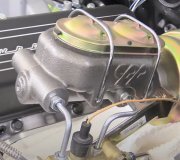Sounds more like its coming from the power steering pump.
HYDRO-BOOST
Though not as common as vacuum booster power brake systems, the Bendix "Hydro-Boost" system dates back to 1973. The system uses hydraulic pressure generated by the power steering pump rather than engine vacuum to provide power assist.
Inside the Hydro-Boost unit, which fits between the master cylinder and brake pedal the same as a vacuum booster, is a spool valve and piston assembly. When the driver steps on the brake pedal, the pushrod slides forward and changes the position of the spool valve. This opens a valve port that routes power steering fluid into the cavity behind the piston to push it forward and apply the brakes.
Another component in the system is a pressure "accumulator." Some are nitrogen pressurized while others are spring loaded depending on the application. The accumulator's job is to store pressure as an emergency backup in case pressure is lost (engine stalls or power steering pump drive belt breaks). There's usually enough reserve pressure in the accumulator for 1 to 3 power assisted stops.
Problems with this system can be caused by spool valve or piston wear inside the Hydro-Boost unit, fluid leaks or loss of pressure (worn pump, slipping pump belt, etc.).
A simple way to test the Hydro-Boost system is to pump the brakes five or six times with the engine off to discharge the accumulator. Then press down hard on the pedal (about 40 lbs. Of force) and start the engine. Like a vacuum booster, you should feel the pedal fall slightly when the engine starts, then rise.
The leakdown of the accumulator can be checked by pumping the brakes several times while the engine is running, then shutting it off. Let the car sit for about an hour, then try the brakes without starting the engine. You should get 2 or 3 soft brake applications before it takes more effort to push the pedal.
Slow brake pedal return may be caused by excessive seal friction in the booster, faulty spool action or a restriction in the return line to the pump. Grabby brakes are probably the result of contamination in the system or a broken spool return spring. If the brakes tend to goon by themselves, you've probably got as case of restricted return flow or a defunct dump valve. Excessive pedal effort can usually be attributed to internal leakage or the seeping of fluid past the accumulator/booster seal.
If a problem turns out to be in the booster itself, you'll have to replace it. Be sure to depressurize the accumulator by pumping the brake pedal half a dozen times before you open up any plumbing connections, other wise you might get blasted by high pressure brake fluid.
SPONSORED LINKS
Thursday, January 29th, 2009 AT 3:20 PM



